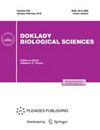中乌拉尔西坡(starisk Rock Shelter,晚全新世)首次发现黄颈鼠(鼠科黄颈鼠)。
Q3 Agricultural and Biological Sciences
引用次数: 0
摘要
在中乌拉尔Olenyi Ruchyi自然公园的Serga河的Starik岩石掩体的全新世沉积物中发现并描述了黄颈鼠(Apodemus flavicollis)的骨骸。这些标本是在2008年的挖掘中收集的,目前收藏在动植物生态研究所的博物馆里。地层背景可追溯到200-300年前。牙齿形态测量学与乌拉尔现代和全新世黄斑古猿种群相匹配。该标本是第一个也是唯一一个记录该物种在中乌拉尔地区发生的标本,为了解该物种在其现代活动范围东部边缘的历史分布提供了重要证据。本文章由计算机程序翻译,如有差异,请以英文原文为准。
The First Find of Yellow-Necked Mouse (Apodemus flavicollis, Muridae, Rodentia) on the Western Slope of the Middle Urals (Starik Rock Shelter, Late Holocene).
Bone remains of the yellow-necked mouse (Apodemus flavicollis) were identified and described from Holocene deposits at the Starik rock shelter (River Serga, Olenyi Ruchyi Nature Park, Middle Urals). The specimens, collected during 2008 excavations, are housed in the museum collection of the Institute of Plant and Animal Ecology. The stratigraphic context dates to 200-300 years BP. Dental morphometrics match both modern and Holocene A. flavicollis populations from the Urals. The specimen is the first and only find documenting the occurrence of the species in the Middle Urals and provides important evidence for understanding the historical distribution of the species at the eastern margin of its modern range.
求助全文
通过发布文献求助,成功后即可免费获取论文全文。
去求助
来源期刊

Doklady Biological Sciences
Agricultural and Biological Sciences-Agricultural and Biological Sciences (all)
CiteScore
1.10
自引率
0.00%
发文量
66
期刊介绍:
Doklady Biological Sciences is a journal that publishes new research in biological sciences of great significance. Initially the journal was a forum of the Russian Academy of Science and published only best contributions from Russia in the form of short articles. Now the journal welcomes submissions from any country in the English or Russian language. Every manuscript must be recommended by Russian or foreign members of the Russian Academy of Sciences.
 求助内容:
求助内容: 应助结果提醒方式:
应助结果提醒方式:


